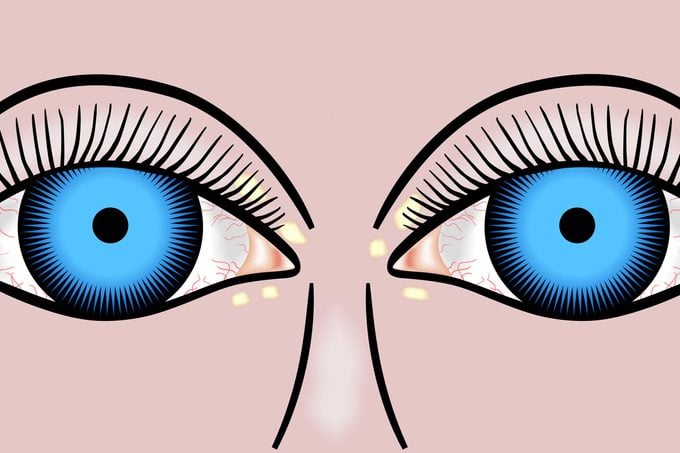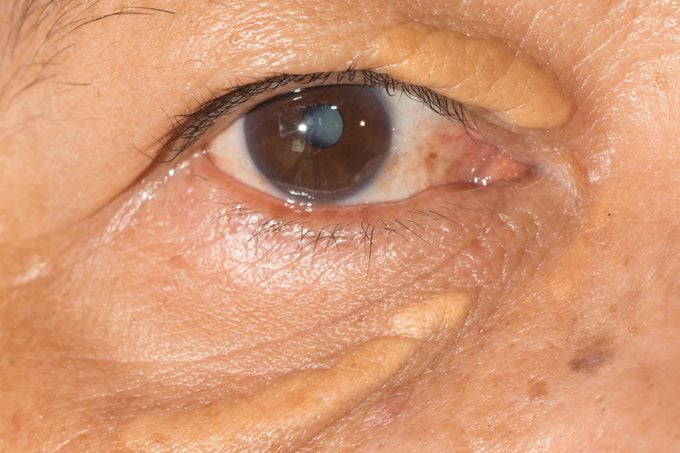What Are Cholesterol Deposits—and How Can You Remove Them?
Updated: Feb. 01, 2021
They aren't dangerous, but you should always talk to your doctor if you see them.
As you get older, you might notice yellowish patches forming around your eyes. Those bumps are actually cholesterol deposits known as xanthelasma and could be a sign that your health is at risk.
Doctors believe xanthelasma shows up when the connection between certain cells inside your capillaries breaks. When that happens, cholesterol can seep out of the blood and into the skin area, where it forms those raised patches, says Adam Scheiner, MD, a laser eyelid and facial cosmetic surgeon in Tampa, Florida.
 Most people with xanthelasma have high cholesterol or lipid problems, which could put you at risk for scary health conditions like a heart attack or stroke, so make sure you’re in tune to these silent signs of heart trouble. Next, set up an appointment with your primary care doctor if you notice them. Still, some people with low or healthy cholesterol levels can still develop xanthelasma, so lowering your cholesterol might not be necessary—or at all useful, says James Gordon, MD, a cosmetic eyelid and facial surgeon in Westchester County, New York. If you do need to lower your “bad” LDL though, avoid these eating habits that are bad for cholesterol.
Most people with xanthelasma have high cholesterol or lipid problems, which could put you at risk for scary health conditions like a heart attack or stroke, so make sure you’re in tune to these silent signs of heart trouble. Next, set up an appointment with your primary care doctor if you notice them. Still, some people with low or healthy cholesterol levels can still develop xanthelasma, so lowering your cholesterol might not be necessary—or at all useful, says James Gordon, MD, a cosmetic eyelid and facial surgeon in Westchester County, New York. If you do need to lower your “bad” LDL though, avoid these eating habits that are bad for cholesterol.
Even though xanthelasma could point to an underlying health problem, the cholesterol deposits themselves aren’t harmful. Still, you might want to get rid of them for cosmetic reasons.
Luckily, you’ve got some options. It’s pretty likely that your xanthelasma will come back even after treatment, says Dr. Gordon, but you can always go back for another.
Laser
For one thing, you could ask about laser treatment. “When I use a laser, I’m actually removing it layer by layer until it’s gone,” says Dr. Scheiner. As the skin heals, all that’s left is healthy new skin—and no cholesterol deposits. (Learn more benefits of using laser treatments for your skin.) But the treatment does have risk of scarring, and can take a week or two to heal, says Dr. Scheiner. A review of published in the 2018 issue of Clinical, Cosmetic, and Investigational Dermatology suggests that using a laser to treat xanthelasma is one of many beneficial options. “Advantages of lasers include better acceptance, avoidance of surgery, minimal tissue loss, good functional and cosmetic results, and therapy repeatability,” the review notes. “Moreover, the procedure is easy to perform and gives fast results.” At the same time, the journal states that results may be unpredictable and the procedure can be costly.
Surgery
The thing is, lasers might not work for thicker cholesterol deposits. In that case, you could get surgery to remove the xanthelasma instead. But that treatment could leave a scar, or even change your eyelid, says Dr. Gordon. “As you pull the skin together or as the wound heals, it can distort the shape of the tissue around it and distort the eyelid or cause an unusual fold,” he says. But the healing process is quicker with surgery, which would be ideal if you don’t want to wait for recovery, says Dr. Scheiner. Plus, your insurance might cover the surgery but not a laser treatment, so check your plan before you decide—and look out for these other plastic surgeries your insurance might actually cover.
Chemical peels
If scalpels and lasers aren’t your thing, ask about a trichloroacetic acid, the compound used in a chemical peel. It’s a less common treatment, but it could get rid of xanthelasma by using a chemical reaction to dissolve the cholesterol deposit, says Dr. Scheiner. Since xanthelasma is linked to high cholesterol, the American Academy of Dermatology suggests getting that under control; improving cholesterol levels may “help clear the growths on your skin.” If that still doesn’t do the trick, the ADA suggests seeing a board-certified dermatologist.
Freeze therapy
You could also look for a doctor who will use cryotherapy to freeze the cholesterol deposit off. Just be aware that hypopigmentation could make the skin in the area get lighter, says Dr. Gordon. The previously-mentioned issue of Clinical, Cosmetic, and Investigational Dermatology refers to cryosurgery as a more modern method, noting that it’s “an outpatient procedure that is safe, relatively painless, effective, cosmetically acceptable, and free of any major complications.” At the same time, the therapy involves several sessions.
Electric needle
During a process called electrodesiccation, a doctor will use a hot needle to create little burns in your skin. “The body has a great ability to repair itself,” says Dr. Scheiner. “If you injure it, it can grow back as better quality skin.” But the electric needles aren’t as precise as lasers and might go deeper than your doctor wants, Dr. Scheiner warns. Therefore, he tends to recommend lasers or surgery instead. Turns out, electrodesiccation may not be ideal for broken capillaries either; turn to other options to help heal the skin. If these options don’t seem to work, other health factors may be at hand. For example, a 2018 issue of the Journal of Cutaneous and Aesthetic Surgery explains that these lipid deposits could also be caused by things like diabetes, pregnancy, and hypothyroidism. Check with a doctor to rule out these and other potential health issues.
